Sun Thaya has depended on his taxi boat for his income for years. On average, he said, he earns around 200,000 kips a month, or about $25, to take tourists to see river dolphins on the border between Laos and Cambodia. When there are no tourists, the Lao boatman just fishes in the area to feed his family.
But now, the father of four said his livelihood could be at stake because the Lao government plans to build a hydropower dam on the Don Sahong channel, a main channel of the Mekong River about two kilometers upstream from where he works.
“I don’t know what to do if the dam is built, but I’ll wait for the government to offer me a job,” he said on his boat. “I can’t say I don’t like the dam, and I can’t ask the government to stop the dam either, I’m afraid.”
Laos has said the proposed dam is needed for the country's economic development because Laos could sell electricity to neighboring countries such as Thailand.
The 260-megawatt project has drawn concern not just from fishermen like Sun Thaya, but also officials, civil society groups and communities in countries all along the Mekong, from upstream Thailand to downstream Cambodia and Vietnam.
In Thailand, communities living along the Mekong say that if built, the Don Sahong dam could damage their livelihoods, which depend on the river’s fish and other natural resources.
Poorapong Pomun, director of the Living River Siam Association in Chiang Mai, said that "in Thailand, we have eight provinces that locate along the Mekong River and the local people have been living and depending on the river for many generations, especially for the fishery, riverbank gardens and for transportation. So this dam will cause a lot of impacts to not only Thai people but the whole region — Thailand, Laos, Cambodia and Vietnam.”
Threat to migrating fish
River experts say the dam would block an important channel of the Mekong — one that fish migrate through all year round.
Opponents say even though the developer intends to modify the plan and use another two channels, the changes still may not be suitable for a majority of migrating fish species.
Tek Vannara, executive director of NGO Forum on Cambodia, said, "Only [a] few fish species migrate through the two channels, so the 60 million people depending on [the] fishery will be affected,” he said.
“Just two kilometers down from the dam site is Cambodia’s Ramsar area, full of deep pools for fish to spawn and provide to Tonle Sap [lake] and other [of] Cambodia’s flooded areas and the Mekong delta, so if Don Sahong dam is built, the migration of a large number of fish species will be blocked.”
At a consultation conference in Laos in December, Vietnam River Network representative Duong Thien appealed for the cancellation of the dam project.
“We call for the Laos government to immediately cancel the Don Sahong dam and for the Vietnamese, Thai and Cambodian governments to take necessary actions to uphold their own responsibility toward the protection of the Mekong River and its people,” she said.
Delay of five years or more
The Vietnamese National Mekong Committee asked that the project be delayed for more studies on transboundary impacts. Nguyen Hong Phuong, deputy director of the committee, said five to 10 years would be needed "to monitor how the fish migrate and how the [alternative] channels are suitable.”
Thai National Mekong Committee member Chaiyuth Sukhsri said more information was needed to understand the interaction of a complex system in the area of Si Phan Don, or Four Thousand Islands, where the proposed dam would be built.
“Even the developer mentioned that this area is a very complex and special area, so immediately from the technical point of view, when you enter or want to do something in a complex system, then you need a lot of information,” he said.
Kol Vathana, secretary-general of the Cambodian National Mekong Committee, said his group wants more time to study the project.
“For the sustainable development and preservation of the Mekong River basin, we, the neighbors of the Mekong River Commission, need a project that is beneficial and does not affect other relevant states or that just has a minimal effect that can be acceptable,” Vathana said.
However, the project developer, Mega First of Malaysia, says the dam would have no significant effect on countries along the Mekong.
Concerns 'are not real'
Critics' concerns "are not warranted; they are not real," said Peter Hawkins, Mega First's environment manager. "The reason is this project, in the scale of hydrodevelopment in this Mekong basin, this project is tiny. It's tiny, very small compared to other major dams upstream in Laos and particularly in China.”
Daovong Phonekeo, director-general of Laos’ Department of Energy Policy and Planning, said, "We’re aware of the concerns, but we have studied the project since 2006 and have a lot of data. We’re very sure the mitigation measures we are going to do would have a minimal impact to the downstream and upstream countries.”
People like Sun Thaya, the Lao fisherman and taxi boat driver, said they just want to be able to still catch fish to feed their families and bring tourists to see dolphins here as usual.
This report was produced in collaboration with the VOA Khmer service.







